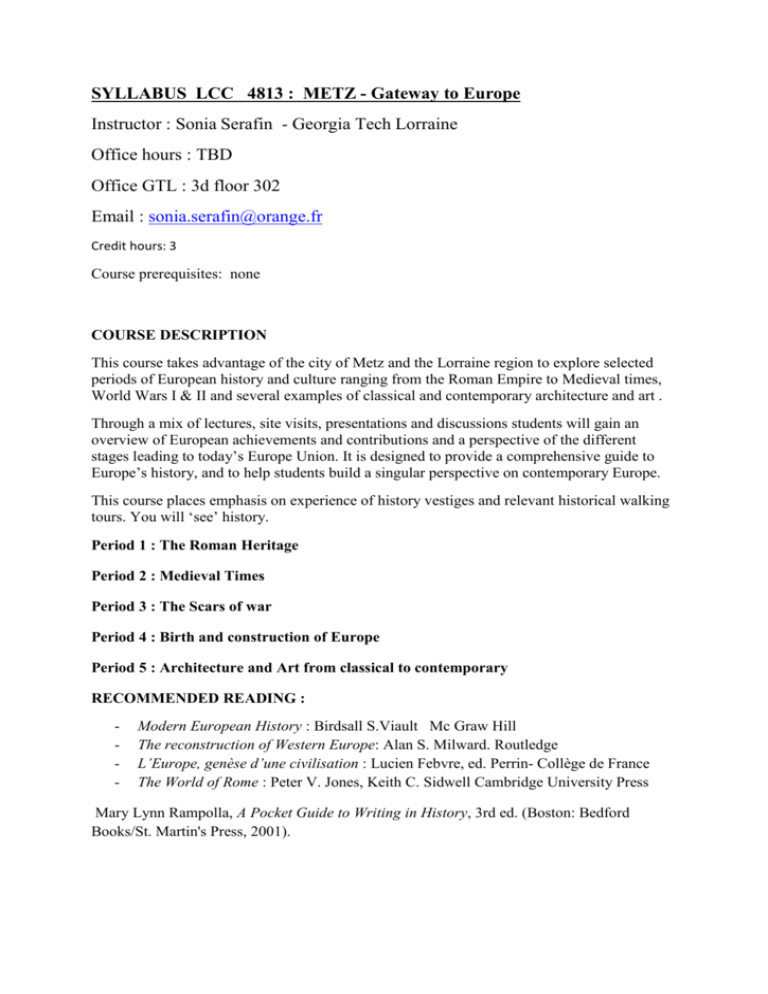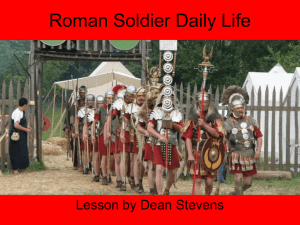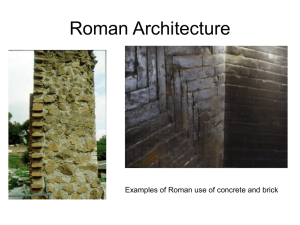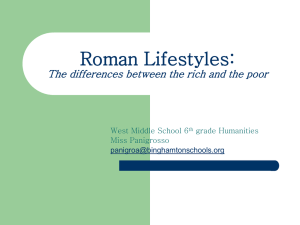METZ - Gateway to Europe
advertisement

SYLLABUS LCC 4813 : METZ - Gateway to Europe Instructor : Sonia Serafin - Georgia Tech Lorraine Office hours : TBD Office GTL : 3d floor 302 Email : sonia.serafin@orange.fr Credit hours: 3 Course prerequisites: none COURSE DESCRIPTION This course takes advantage of the city of Metz and the Lorraine region to explore selected periods of European history and culture ranging from the Roman Empire to Medieval times, World Wars I & II and several examples of classical and contemporary architecture and art . Through a mix of lectures, site visits, presentations and discussions students will gain an overview of European achievements and contributions and a perspective of the different stages leading to today’s Europe Union. It is designed to provide a comprehensive guide to Europe’s history, and to help students build a singular perspective on contemporary Europe. This course places emphasis on experience of history vestiges and relevant historical walking tours. You will ‘see’ history. Period 1 : The Roman Heritage Period 2 : Medieval Times Period 3 : The Scars of war Period 4 : Birth and construction of Europe Period 5 : Architecture and Art from classical to contemporary RECOMMENDED READING : - Modern European History : Birdsall S.Viault Mc Graw Hill The reconstruction of Western Europe: Alan S. Milward. Routledge L’Europe, genèse d’une civilisation : Lucien Febvre, ed. Perrin- Collège de France The World of Rome : Peter V. Jones, Keith C. Sidwell Cambridge University Press Mary Lynn Rampolla, A Pocket Guide to Writing in History, 3rd ed. (Boston: Bedford Books/St. Martin's Press, 2001). COURSE ASSESSMENT AND ATTENDANCE Attendance : 40 % Attendance to this course is mandatory. Postings : 20 % A summary e-mail will be sent after each day of field trip. Final research paper : 40 % : The required paper is a 7 page documented, typed, double spaced essay. It must address a topic of historical or cultural importance concerning Europe. It is due two weeks after the last visit. Students must first submit a written proposal and bibliography/webography. I will provide more details later in the semester. All work will be evaluated on its clarity, strength of analysis, historical and cultural contents. COURSE OUTLINE The exact schedule of class meetings changes each term. There will be lectures during week days and three weekends of field trips. THE ROMAN HERITAGE Visit of the European Archaeology Park in Bliesbrück (France) - Reinheim (Germany) The set up of the park enables a better understanding of all the stages of research, from archaeological digs to the restoration of a buried past. Set across two countries : France and Germany, the park is an outstanding site that was buried in the depths of a Lorraine valley. It includes many valuable artefacts and remains from the Bronze Age, the reconstruction of the tomb of Celtic Princess (400 B.C.), a Gallo Roman villa, a craftsmen’s district and Roman baths. Guided visit by head archaeologist. Visit of the City of TRIER (Germany) Trier is Germany's oldest city. Legend has it that in 2000 BC the Assyrians established a colony here. The Roman colony of Augusta Treverorum (Trier) was founded by Augustus in 16 BC. Trier became a favored residence of several Roman emperors, including Constantine the Great, the first Christian emperor. The cathedral Constantine built in Trier in 326 AD is Germany's oldest. Visit of the Cathedral Imperial Roman Baths, Roman Amphitheater, Roman Gates ‘Porta Nigra’. Visit of the Cour d’Or Museum (Metz) This history and archeological museum, contains rich collections of Gallo-Roman finds — extension works to the museums in the 1930s revealed the vestiges of Gallo-Roman baths and remarkable artefacts from the Gallo- Roman, Merovigian and Medieval era. Visit of the Roman Aqueduct in Jouy aux Arches (Metz) Arches from a 2nd century Roman aqueduct (formerly bringing water to Metz) pass through a village (Jouy) and continues over on the opposite bank of the Moselle River in Ars. Evidence of the exceptional length (22 kms) of this masterpiece of Roman engineering.. Film : Rome and its engineers followed by a lecture and discussion on the fall of the Roman Empire. At GTL MEDIEVAL TIMES As a land between four countries (France, Germany, Luxemburg and Belgium) Lorraine has always been a place in which to test systems of defence. Many military architects (from Louis XIV’s Chief Engineer (Vauban) to the Maginot Line) built massive stone constructions, as lookout posts and as protection against invasion. Visit of the Malbrouck’s Castle – (Manderen) The castle is located in the "Land of the Three Borders", where the boundaries of France, Germany and Luxembourg converge. Built by Arnold VI of Sierck in the 15th century, Malbrouck was named after the Duke of Marlborough, who stayed there during the War of the Spanish Succession. In 1705, this English nobleman planned to invade France and turn the castle into a bridgehead. When reinforcements failed to arrive, he left the site without having fired a shot. Owned by the Moselle General Council, the castle re-opened to the public in 1998 after a ten-year restoration. In compliance with the Venice Charter, the castle has been restored to its historic appearance. Anything not certified as original was rebuilt using modern materials. The exterior, which scarcely underwent any changes over the centuries, is an ac cu rate example of medieval architecture. Visit of the Dukes of Lorraine Castle – (Sierck) The castle in Sierck-les-Bains stands on the ruins of a Gallo-Roman fortress built at a still unknown date. It was one of the favorite residences of the dukes of Lorraine, who stayed there often with their courts. The castle was besieged several times by Charles the Bold in 1475 and the Grand Condé in 1643 before being integrated into the kingdom of France in 1661. Throughout the centuries it underwent constant rebuilding to keep pace with the latest advances in warfare, in particular the appearance of artillery. It has not changed since the late 15th century, but new buildings were added in the 18th. The castle was disarmed, dismantled and restored several times until 1866, when it was definitively decommissioned. The castle's strategic position, in the Moselle Valley, accounts for its longevity Visit of a fortress and medieval village –(Rodemack) Rodemack has been occupied, fought over and exchanged by the countries bordering the ‘Land of the Three Borders’ (France, Germany and Luxembourg) many times, but it became officially French in 1769. Most of its buildings date from the 14th to the 19th century. THE SCARS of WARS Visit of Fort Queuleu – (Metz) During the Annexation of the Moselle during World War I the fort was used starting in 1943 by the German occupiers as an internment camp (S Sonderlager) for members of the French Resistance, The fort was called the "Hell of Queuleu" . It was not a concentration camp, but an interrogation center for captured or arrested members of the Resistance. Visit of Fort Hackenberg - Maginot Line. (Veckring) This Maginot Line fortification has 10km of galleries and 17 combat blocks covering an area of 1.6 km2. The installations of the period (power plant, ammunition storage, barracks ...) are in working order. Presentation and debate : Maginot Line graphic novel. At GTL Visit of Lorraine American Cemetery and Memorial (St. Avold ) Europe's largest American World War II military cemetery with 10,489 graves of American soldiers. Lecture : History of the Lorraine Region. The three wars. At GTL BIRTH AND CONSTRUCTION OF EUROPE The beginning : Centre Européen Robert Schuman – Scy Chazelles Visit of the Centre’s exhibition and Robert Schuman’s residence. . Robert Schuman, the ‘Father of Europe’ was responsible for the first step on the way to the Common Market and the European Union. He lived in Scy-Chazelles near Metz. Conference : The history of the construction of the European Union . Centre Européen Lecture : The decision process in the European Union : the European Commission, the European Parliament, the Council of Europe. At GTL ARCHITECTURE AND ART Visit of St. Stephen’s Cathedral - (Metz) One of the finer cathedral in France, la Cathédrale de Saint Etienne, a gothic masterpiece, was constructed in many stages between 1220 and 1550 by bringing together the nave of the St Etienne church and an older Roman church. It boasts the largest surface of polychromatic stained-glass artwork in the world (with 6 500m²). Lecture : History of the Cathedral. In situ Visit of the Salmon stained glass restoration workshop – (Metz) Master craftsmen will show how to restore or create stained glass. They have been restoring the windows of the St Stephen’s cathedral for decades. Visit of the Imperial Quarter – (Metz) A unique and entirely preserved example of 19th century German town planning with neoRoman, Gothic, Renaissance and Art Deco buildings. Visit of the Pompidou Centre – (Metz) The architecture of this remarkable modern art museum has unusual characteristics : A large hexagonal structure, a very big central nave, three large open rectangular exhibition spaces and a highly innovative architectural relation between interior and exterior. Visit of the Trinitaires Abbey Cloister, the Récollets Convent, Saint-Pierre-auxNonnains (France’s oldest church)-(Metz) Following is a list of research papers presented by former students. Some topics have been presented several times. These are given as examples. You can choose another topic. Roman heritage : Symbols of an Empire : the arch and the amphitheatre Roman Numerals Roman engineering : Viaducts Roman engineering : Aqueducts Roman engineering : the arch The controversy and life of Nero Roman gladiators Roman baths: inside the walls Rome and Christianity The Coliseum and its features Hadrian’s wall Engineering prominence of Ancient Rome The Ludi : Roman games Aqueducts : lifelines of civilizations Medieval times : Medieval castle architecture Joan of Arc Charlemagne the Conqueror The beauty of stained glass Evolution of stained glass in Europe Scars of wars : WWII : creation of resistance underground newspapers D-Day : News coverage, Propaganda and Perceptions Lafayette, the passionate hero The Maginot Line America’s Role in France in WW2 The cross of Lorraine Sébastien de Vauban Priest The Metz Jewish community. Study of the Maginot Line as a defensive emplacement The Iron Men of Metz : 95th infantry division of the US army Torture techniques during World War II The occupation of France Art and architecture : Art nouveau Symbols of Lorraine, Moselle and Metz Shigeru Ban Architect Marc Chagall The beauty of stained glass Evolution of stained glass in Europe An experience with stained glass







